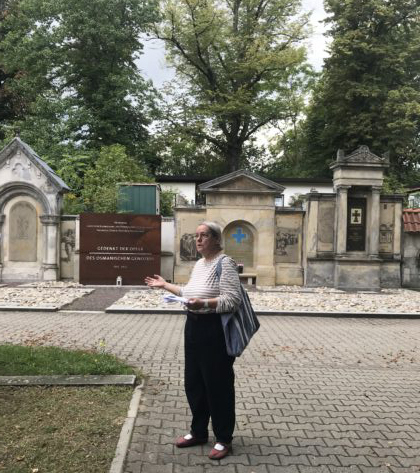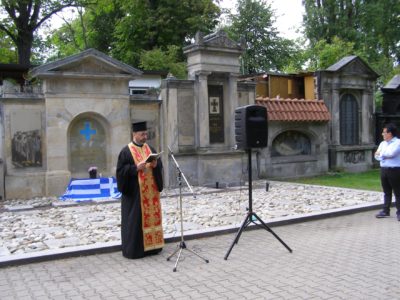
Tessa Hofmann presents memorial monuments
Berlin Greek Orthodox Community Commemorates Genocide Victims
by Muriel Mirak-Weissbach
BERLIN, SEPTEMBER 16, 2021—Every year in mid-September, members and friends of the Greek Orthodox community in Berlin gather at the Luisenkirchhof III cemetery to honor the memory of the victims of the genocide. On September 11, the Day of the Open Monument, participants took part in a tour of the cemetery led by Dr. Tessa Hofmann, co-founder and spokeswoman of the organization behind the initiative (FÖGG). On Sunday, September 12, she delivered an address at the commemorative ceremony, where a wreath was laid, and Archimandrite Dr. Stefan L. Toma, of the Greek Orthodox Church of Christ’s Ascension, offered requiem prayers.
Among those who attend these events are Armenian as well as Aramaean/Assyrian/Chaldean Christians. The site is known as the Altars of Remembrance. A unique monument embodying the spirit of ecumenicism, it occupies a special place in Germany’s culture of remembrance, as the story of its origins reveals. Hofmann shared this history while guiding visitors through the cemetery.
At the beginning of the 20th century, an estimated five million indigenous Christians from these communities lived in what is today Turkey, and over three million perished on orders of the Ottoman regime, through deportations, massacres and slave labor.
When, in the second half of the 20th century, large numbers of Greeks and other Christians arrived in Germany from Turkey and countries of the Middle East, they were de facto refugees. Many of them were descendants of genocide survivors, and could be described as carrying little luggage but a heavy burden of memory. Most painful must have been the memory of those relatives denied proper burial, and whose final resting place, in modern day Syria, Turkey and northern Iraq, had become inaccessible.
Thus, their desire and need for sites of personal and community commemoration in their new homeland was great. Not only as a place for mourning, but also as a symbolic warning or admonition, never to allow a repetition of such crimes against humanity.
In 2002, the “Speaking with One Voice!” organizing committee was set up, a civil society group calling for recognition in the German Bundestag (Parliament) of the 1912-1922 genocide against Ottoman Christians. In 2008 it launched the initiative for an ecumenical remembrance site in Berlin and received support from local political figures in Charlottenburg, a district with a strong historical connection to Armenian-Turkish-German history. Two of Berlin’s Armenian communities as well as a Syrian Orthodox community are located here.
In early 2012 the Promotional Society for the Ecumenical Monuments for Genocide Victims of the Ottoman Empire (FÖGG) came into being. That May, the Evangelical Luisengemeinde (Parish) made available three abandoned burial sites, where three Altars of Remembrance would be erected, dedicated to the Armenians, Greeks and Aramaean/Assyrians, respectively. (See https://mirrorspectator.com/wp-content/uploads/2018/03/March-3-2018-1.pdf ) Norms for conserving historical monuments guided the renovation work in 2015 to transform three memorials into altars, and construction work was completed in 2018.
The Luisenkirchhof III cemetery itself was established in the nineteenth century. Native trees, beech, oak, maple and linden, adorn its broad avenues and geometrical layout, reflecting the ideas of garden architect Gustav Meyer (1816-1877) and his student, Otto Vogeler (1843-1913), who planned the landscaping. The grounds, which offer a perfect location for the ecumenical monuments, have been granted official protection as a natural and historical site.

Dr. Stefan L. Toma offers requiem prayers
Refugees, Greek Islands Then and Now
In her remarks during the Sunday commemorative gathering, Hofmann drew parallels between the genocide a century ago, and the situation today. She recalled the conquest of the defenseless Ionian port city Smyrna (Izmir) on September 9, 1922 and its wanton destruction, which “marked one of the greatest refugee tragedies of the 20th century.” Then, as now, she went on, the question was, what countries would take them in? She cited correspondence between the American Dr. Esther Pohl-Lovejoy, who was in Smyrna, and Dr. Mabel Evelyn Elliott from the American Women’s Hospitals (AWH), the medical director of the health department for refugees of the Near East Relief (NER). Dr. Elliott portrayed the incredible challenge posed by the need to rescue and transport almost a million refugees within a matter of weeks. In a letter dated January 16, 1923, Dr. Elliott described the conditions under which survivors travelled on ships leaving Turkey. The setting was unimaginable, she wrote, and worse, the refugees had trekked days and weeks through Anatolia’s snow-covered mountains, before boarding ships taking them through the Black Sea, Bosporus, Marmara and Aegean seas. Those who had perished during the voyage could not be buried and had to be burned in the ship’s furnaces.
When the ships arrived at the Greek coasts, the government and aid organizations were utterly overwhelmed; in 1923, about a million refugees were coming to a land with a population of 5 million. Hofmann cited an October 11, 1922 telegram dispatched by Dr. Fridtjof Nansen, League of Nations High Commissioner for Refugees. Nansen estimated that no fewer than 750,000 refugees, mainly women and children, were scattered throughout Greece, Thrace and the islands. While he praised the efficiency of the evacuation, which had saved lives, he lamented their condition, without money, clothing, shelter or food.
Then, due to the widespread threat of contagion, the refugees were put in mass quarantine on the Cyclades island of Makronisos, which was small and lacked adequate infrastructure. The Greek government, the only one that had taken in Armenian and Greek refugees of the genocide, had reached the limit and would accept more only on condition they were free from disease, and clean. Dr. Olga Stasny from AWH, who was in charge of setting up the refugee camp, described a situation where even adequate drinking water was scarce. No telephone, no telegraph, no radio communications — and yet, the AWH was supposed to prepare to receive the refugees within 10-12 days.
“The quarantine in Makronisos lasted from January to June 1923,” Hofmann said, “Over 20,000 refugees from Turkey passed through the camp on the small island.” She continued: “Hopelessly overcrowded refugee camps on Greek islands — like Moria — create an image to the present day of misery and unsolved humanitarian problems. It is shocking to see how little has changed or improved in almost a hundred years. What have we learned? What has become of the mantra-like repeated call, ‘Never again?’”
Hofmann concluded with reference to next year, 2022, which marks the centenary of the conquest and catastrophe of Smyrna, “an occasion to reflect seriously on the decade-long genocide against Ottoman Christians, as well as the accompanying humanitarian catastrophes.”